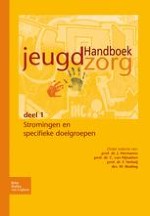Gepubliceerd in:
2005 | OriginalPaper | Hoofdstuk
11. Integratieve psychotherapie
Samenvatting
Psychotherapie is in Nederland vooralsnog een wettelijk beschermde activiteit. De professional hanteert methodisch de relatie die hij met iemand met een hulpvraag aangaat teneinde tot oplossing van diens problematiek te geraken. Methodisch de relatie hanteren betekent communiceren via spel, gesprek en/of handelen.
